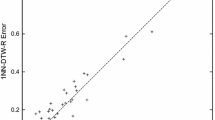Abstract
Time series classification, due to its applications in various domains, is one of the most important data-driven decision tasks of artificial intelligence. Recent results show that the simple nearest neighbor method with an appropriate distance measure performs surprisingly well, outperforming many state-of-the art methods. This suggests that the choice of distance measure is crucial for time series classification. In this paper we shortly review the most important distance measures of the literature, and, as major contribution, we propose a framework that allows fusion of these different similarity measures in a principled way. Within this framework, we develop a hybrid similarity measure. We evaluate it in context of time series classification on a large, publicly available collection of 35 real-world datasets and we show that our method achieves significant improvements in terms of classification accuracy.
Access this chapter
Tax calculation will be finalised at checkout
Purchases are for personal use only
Preview
Unable to display preview. Download preview PDF.
Similar content being viewed by others
References
Bauer, E., Kohavi, R.: An empirical comparison of voting classification algorithms: Bagging, boosting, and variants. Machine Learning 36(1), 105–139 (1999)
Buza, K., Nanopoulos, A., Schmidt-Thieme, L.: Time-Series Classification based on Individualised Error Prediction. In: International Conference on Computational Science and Engineering. IEEE, Los Alamitos (2010)
Chan, K., Fu, A.: Efficient time series matching by wavelets. In: 15th International Conference on Data Engineering, pp. 126–133 IEEE, Los Alamitos (1999)
Christen, P.: Automatic record linkage using seeded nearest neighbour and support vector machine classification. In: Proc. of the 14th ACM SIGKDD International Conference on Knowledge Discovery and Data Mining, pp. 151–159. ACM Press, New York (2008)
Dietterich, T.: An experimental comparison of three methods for constructing ensembles of decision trees: Bagging, boosting, and randomization. Machine Learning 40(2), 139–157 (2000)
Ding, H., Trajcevski, G., Scheuermann, P., Wang, X., Keogh, E.: Querying and mining of time series data: experimental comparison of representations and distance measures. Proceedings of the VLDB Endowment 1(2), 1542–1552 (2008)
Hastie, T., Tibshirani, R., Friedman, J.: The elements of statistical learning: data mining, inference, and prediction, ch.5 Springer, Heidelberg (2009)
Keogh, E., Kasetty, S.: On the need for time series data mining benchmarks: A survey and empirical demonstration. Data Mining and Knowledge Discovery 7(4), 349–371 (2003)
Keogh, E., Shelton, C., Moerchen, F.: Workshop and challenge on time series classification (2007), http://www.cs.ucr.edu/~eamonn/SIGKDD2007TimeSeries.html
Keogh, E.J., Pazzani, M.J.: Scaling up dynamic time warping for datamining applications. In: 6th ACM SIGKDD Int’l. Conf. on Knowledge Discovery and Data Mining, pp. 285–289. ACM,New York (2000)
Ratanamahatana, C., Keogh, E.: Everything you know about dynamic time warping is wrong. In: SIGKDD Int’l. Wshp. on Mining Temporal and Seq. Data (2004)
Ratanamahatana, C., Keogh, E.: Making time-series classification more accurate using learned constraints. In: SIAM Int’l. Conf. on Data Mining, pp. 11–22 (2004)
Rath, T.M., Manmatha, R.: Word image matching using dynamic time warping. In: Conference on Computer Vision and Pattern Recognition, vol. 2. IEEE, Los Alamitos (2003)
Romano, L., Buza, K., Giuliano, C., Schmidt-Thieme, L.: XMedia: Web People Search by Clustering with Machinely Learned Similarity Measures. In: 18th WWW Conference on 2nd Web People Search Evaluation Workshop, WePS 2009 (2009)
Sakoe, H., Chiba, S.: Dynamic programming algorithm optimization for spoken word recognition. Acoustics, Speech and Signal Processing 26(1), 43–49 (1978)
Schuller, B., Reiter, S., Muller, R., Al-Hames, M., Lang, M., Rigoll, G.: Speaker independent speech emotion recognition by ensemble classification (2005)
Sonnenburg, S., Ratsch, G., Schafer, C., Scholkopf, B.: Large scale multiple kernel learning. The Journal of Machine Learning Research 7, 1531–1565 (2006)
Ting, K., Witten, I.: Stacked generalization: when does it work?. In: 15th Int’l. Joint Conf. on Artifical Intelligence, vol. 2, pp. 866–871. Morgan Kaufmann, San Francisco (1997)
Zhang, G., Berardi, V.: Time series forecasting with neural network ensembles: an application for exchange rate prediction. Journal of the Operational Research Society 52(6), 652–664 (2001)
Zhou, Z., Wu, J., Tang, W.: Ensembling neural networks: Many could be better than all. Artificial intelligence 137(1-2), 239–263 (2002)
Author information
Authors and Affiliations
Editor information
Editors and Affiliations
Rights and permissions
Copyright information
© 2011 Springer-Verlag Berlin Heidelberg
About this paper
Cite this paper
Buza, K., Nanopoulos, A., Schmidt-Thieme, L. (2011). Fusion of Similarity Measures for Time Series Classification. In: Corchado, E., Kurzyński, M., Woźniak, M. (eds) Hybrid Artificial Intelligent Systems. HAIS 2011. Lecture Notes in Computer Science(), vol 6679. Springer, Berlin, Heidelberg. https://doi.org/10.1007/978-3-642-21222-2_31
Download citation
DOI: https://doi.org/10.1007/978-3-642-21222-2_31
Publisher Name: Springer, Berlin, Heidelberg
Print ISBN: 978-3-642-21221-5
Online ISBN: 978-3-642-21222-2
eBook Packages: Computer ScienceComputer Science (R0)




